Poynting XPOL-1 User Guide

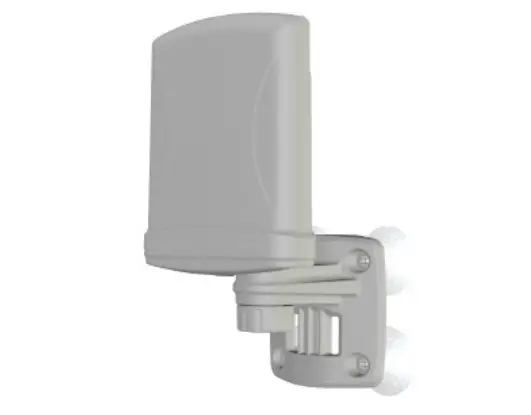
South Africa
Unit 4, N1 Industrial ParkLandmarks AveSamrand, 0157,South AfricaTel: +27 12 657 0050[email protected]
Europe
Kronstadler Straße 4,81677 MünchenGermanyTel: +49 89 2080 265 38Mob.: +49 176 529 733 50[email protected]
Version: 3.0
Packing Check List
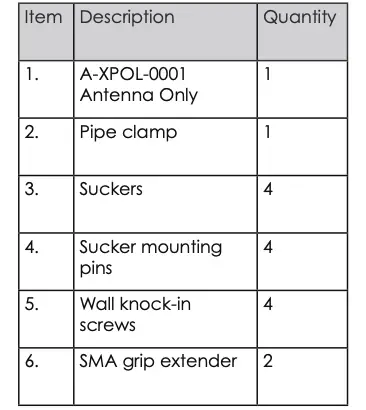
The appearance of each component
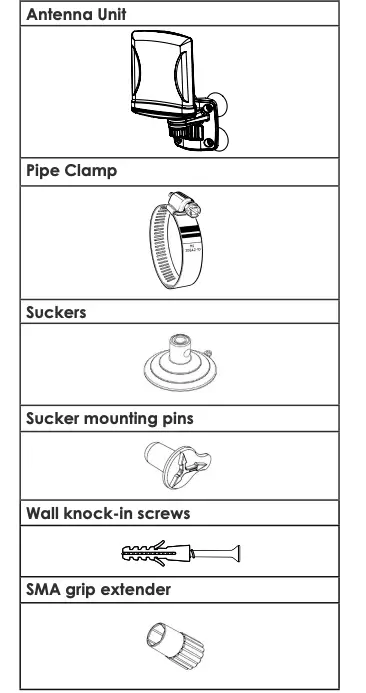
Tools Required
Tools that may be required:
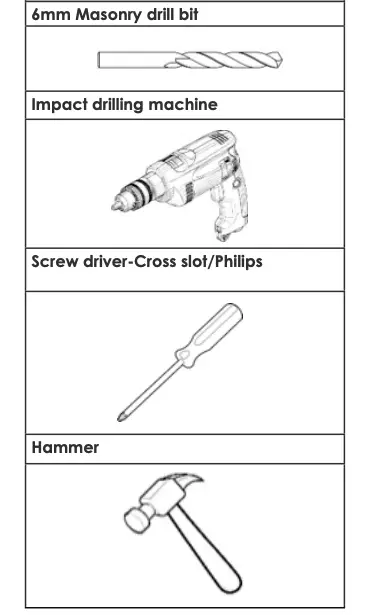
Introduction
XPOL-1 is a unique window, wall or pole mountable, high gain, CPE antenna. It can be mounted outdoors on a pole of up to 50mm in diameter, against a window or against a wall. Follow the instructions below for installation.
Mounting Configurations:
1. Wall Mounting
- Select a suitable place for mounting the antenna.
- Use a 6mm masonry drill bit to drill four holes into the wall. See the dimensions below.
- Place the bracket over the four holes and line up the holes in the bracket with the holes in the wall. Place the four knock-in screws to mount the bracket to the wall.
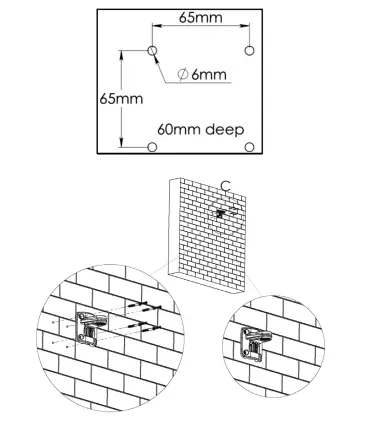
2. Window Mounting
- Select a suitable mounting place for mounting the antenna.
- Clean the selected area to remove the dirt.
- Place each of the four suckers through the holes in the bracket.
- Insert the sucker pins from the front of the bracket into the hole in the four suckers.
- Carefully press the antenna suckers against a window, taking caution not to damage or break the window.
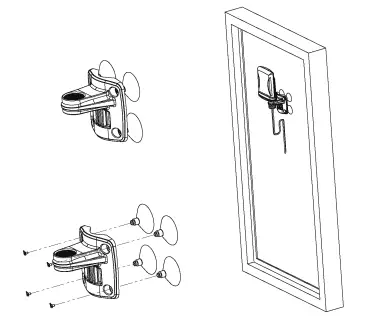
3. Pole Mounting
- Lay the antenna out at the installation site and assemble the antenna on the ground.
- Place the pipe clamp through the bracket as shown below.
- Next place the cable clamp around the pole and tighten the screw on the cable clamp until the bracket is secured to the pole.
- Mount the antenna so that there is at least 1 meter of clearance in all directions around it and unobstructed line of sight to the cell tower’s strongest signal.
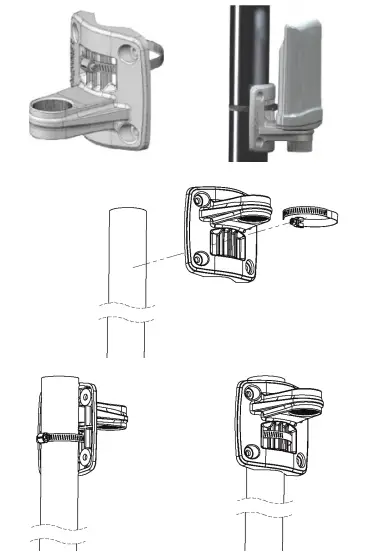
Antenna Alignment
- Use appropriate equipment (signal meter or App) to locate the nearest cellular tower in your location as well as the greatest signal strength for the antenna to draw upon.
- Once you have located the tower, point the main center beam of your antenna in the general direction of the cell tower.
Note: Recommended beam width is 70°
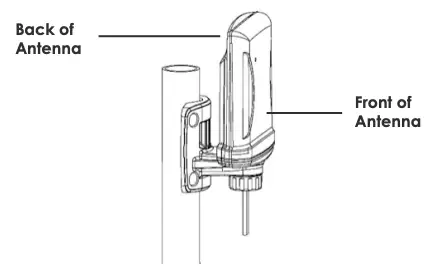
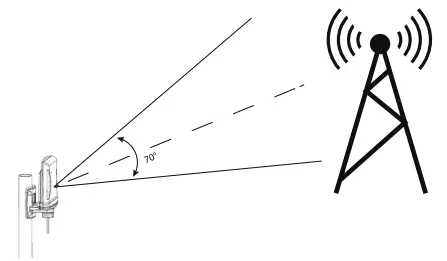
- To optimise the antenna alignment, rotate the antenna left and right in 15° increments until you get the best signal strength reading. Lock the antenna down at the position where you get the best signal strength.
Note: When rotating the antenna, be sure to let go of the antenna as this may give inaccurate readings.
Antenna Mounting Precautions
- Place the antenna at the highest point possible and ensure that there aren’t any surrounding obstructions to the antenna.
- In order to avoid communication interference, ensure that the antenna is placed at least 0.5m away from other antennas and metal objects.
- Avoid installing the antenna near a chimney, as the smoke and soot emitted by the chimney can obstruct the signal level achieved by the antenna.
- Install the antenna away from heat sources and flammable gases.
Cable Routing
- If the antenna is mounted on a pole, avoid wrapping the cables around the pole. Route the antenna cables straight down the inside of the pole to avoid using extra equipment such as cable ties.
- Use the minimum cable length required. Do not run more cable than needed to ensure minimum cable losses are achieved.
- Never pull on the cable connectors; pull only on the cable ensuring the cable is not under tension.
- The allowable cable bend radius is 30mm.
- Cover connectors with insulation tape before threading them through a hole.
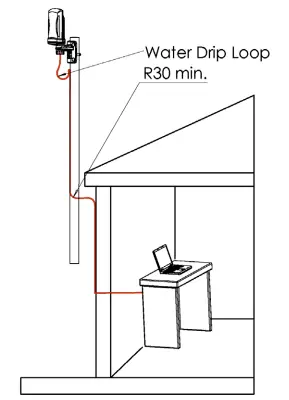
Safety
- If you are installing an antenna for the first time or unsure about how to install your antenna, obtain the help of a professional installer.
- Carefully survey the installation site before installation to locate secure handholds, dangerous conditions (such as power lines and weak roofs) and the safest and most convenient placement for ladders if necessary.
- When installing your antenna, remember:
- Do not install near power lines as they can electrocute you.
- Do not install on a wet or windy day or when lighting or thunder is in the area.
- Wear shoes with rubber soles and heels and protective clothing (long sleeve shirt or jacket) and rubber gloves.
- Avoid operating while under the influence of drugs, alcohol or medication.
- Make sure that any loose fitting jewellery or clothing is secured and tie back long hair as they can get caught in moving parts during installation.
- If the antenna assemble starts to fall, get away from it and let it fall to avoid harm to yourself.
- When drilling, remember
- Use safety goggles when drilling the holes.
- Avoid using bits that are dull, bent or damaged.
- Be aware of where your fingers are in relation to the drill bit when using the drilling machine.
- To stop the drilling machine, let the drill chuck come to a complete stop on its own. Do not grasp the chuck in an attempt to stop the drill bit.
- Avoid awkward hand positions where a sudden slip could cause a hand to move into the drill bit or cutting tool.
CAUTION:
Antennas must be installed to provide a separation distance of at least 20cm from all persons so as to comply with SAR (Specific Absorption Rate) RF Exposure requirements.
 European Waste Electronic Equipment Directive 2002/96/ECPlease ensure that old waste electricals and electronics are recycled.
European Waste Electronic Equipment Directive 2002/96/ECPlease ensure that old waste electricals and electronics are recycled.
Directive 2011/65/EU (RoHS 2)
This product is fully compliant with the RoHS 2 directive.
[xyz-ips snippet=”download-snippet”]


